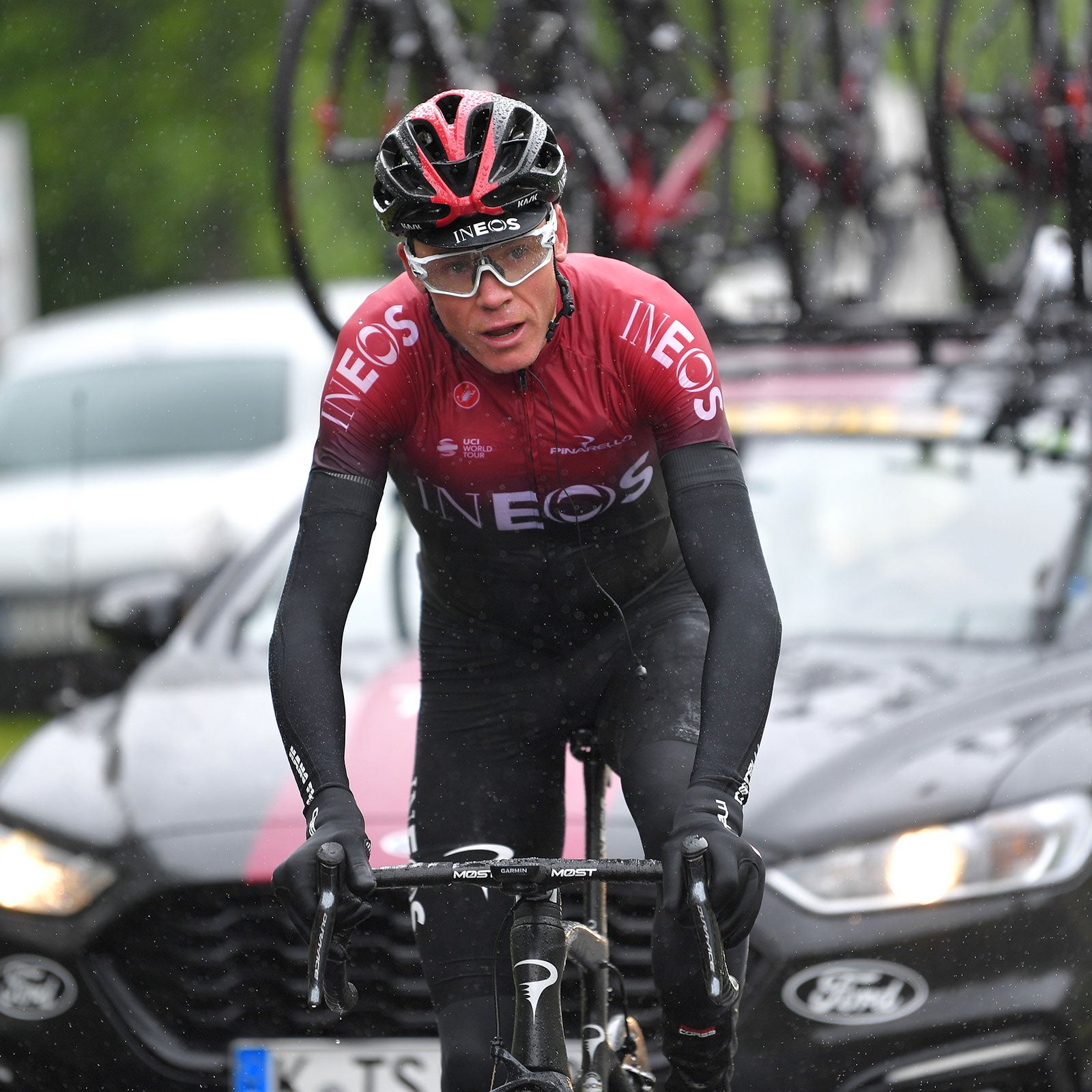It was the kind of move pro racers do all the time┬áwithout a thought. Four-time Tour de France winner Chris Froome was in the midst of a recon of WednesdayÔÇÖs individual time trial stage at the Criterium du Dauphine stage race, a key Tour tune-up, when he raised a hand to blow a simple snot rocket.
ÔÇťAt the start of the descent, Chris wanted to blow his nose and, at that moment, a sharp gust of wind pushed him against a low wall along the side of the road,ÔÇŁ Team Ineos general manager Dave Brailsford┬á. At the time, Froome was riding a time-trial bike with a high-profile front wheel thatÔÇÖs more prone to being pushed around in gusty conditions. According to reports, Froome was going 37 miles per hour when he hit the wall. He is definitely out of the 2019 Tour de France.┬á
Team Ineos issued a press release on Wednesday┬ádetailing FroomeÔÇÖs injuries: a fractured right femur, elbow, ribs (the team didnÔÇÖt say how many), and . Froome didnÔÇÖt lose consciousness┬ábut was apparently in the moments after the crash. He was taken by an ambulance and then helicopter to a regional hospital in Roanne, and was transferred again to a larger facility in Saint-Etienne. ÔÇťItÔÇÖll take quite a long time before he races again,ÔÇŁ said Brailsford, .
Those are chilling words. Brailsford normally puts on an optimistic face for the press, whatever the circumstances; for him to sound so grim in this situation is telling. And heÔÇÖs likely right that we wonÔÇÖt see Froome again for some time, almost certainly not until next season.
The femur is the largest bone in the body. ItÔÇÖs a relatively rare one for pro cyclists to break. Collarbone, pelvis, and wrist fractures are far more common. But partly because of its size, a broken femur also requires┬áa longer and more uncertain recovery than other types of fractures. A ┬áof four professional ball-sports athletes who sustained broken femurs found an average return-to-competition time of 9.5 months. ÔÇťReturn to play is possible … within one year under ideal circumstances,ÔÇŁ the authors wrote, noting that subsequent surgery for hardware removal┬áor soft-tissue injuries related to the fracture┬ácould complicate that timeline.
Froome is the second pro to fracture a femur this season. The other, Israel Cycling AcademyÔÇÖs Nathan Earle, suffered his injury on April 6 at the Gran Premio Miguel Indurain. Understandably, he hasnÔÇÖt raced since.
Though unusual, injuries like FroomeÔÇÖs and EarleÔÇÖs arenÔÇÖt unheard ofÔÇöand most of the racers┬áultimately return┬áto pro cycling. One, Jack Bauer, is still racing at the WorldTour level four years after his injury. But in other instances, the racersÔÇÖs post-crash careers tell something of a cautionary tale about the long-term impacts of such a serious injury.
In maybe the most analogous case in recent history, Spanish racer Joseba Beloki crashed heavily in the 2003 Tour and broke his femur. (This was the stage where Lance Armstrong made his in a switchback to avoid BelokiÔÇÖs crash.)┬áBeloki returned to competition in March 2004┬áand raced three more seasons at the sportÔÇÖs top level before retiring in 2006. Prior to the injury, Beloki was one of the better stage racers of his era, with three Tour de France podiums. Post-crash, he struggled to finish stage races and never finished higher than 40th in a three-week Grand Tour.
Also in 2003, American Floyd Landis suffered a femoral neck fracture┬áin a training crash,┬ádamaging blood supply to the bone and . He won the 2006 Tour, at age 30, on a deteriorating joint that required a full hip replacement that fall. Because of his positive test at that yearÔÇÖs Tour and subsequent two-year ban, weÔÇÖll never know how quickly he could have returned to racing following his surgery. But the complications he suffered are a stark example of the kind of lingering problems that a femur fracture can cause.
Not all stories are that bleak. Alexandre Vinkourov, a former top pro and Grand Tour contender, broke his femur at age 38 in the 2011 Tour de France. He came back in three months and then won the 2012 Olympic road race. But he also retired the following year, and his stage-race results in that season were lackluster at best. 
Brailsford declined to speculate on any long-term prognosis for FroomeÔÇÖs career, saying that it was simply too early to know. But FroomeÔÇÖs injury may be worse than the femur fractures some other riders have faced. An noted that a witness to the accident said Froome had suffered an open (or compound)┬áfracture, which means that a bone fragment ┬áIf thatÔÇÖs true, itÔÇÖs concerning, because this kind of break┬ácan cause additional injuries┬áand increase the risk of infection. The AFP quoted Brailsford as saying Froome was in ÔÇťa very, very serious condition.ÔÇŁ
And, past FroomeÔÇÖs initial recovery, thereÔÇÖs the question of his age and where he will fit┬áin IneosÔÇÖs long-term plans. Froome just turned 34, four years older than Beloki at the time of his crash. We likely wonÔÇÖt seem him return to competition until at least spring 2020.┬áEven if heÔÇÖs racing again by then and there are few complications, the 2020 Tour may be too early for him to have returned to full strength.
Froome was already one of the older Tour winners in the raceÔÇÖs history. In the raceÔÇÖs postÔÇôWorld War II┬áera, just four riders (Gino Bartali, 1948; Joop Zoetemelk, 1980; Lance Armstrong, 2005; and Cadel Evans, 2011) won a Tour at age 34. Only one Tour rider in┬áhistory,┬áFirmin Lambot, was over 35, and that was almost 100 years ago.┬áEven before the injury, FroomeÔÇÖs window for a record-tying fifth Tour win was starting to close.
And┬áFroome will return to a crowded roster at Ineos, including┬ádefending Tour winner Geraint Thomas, who is only a year younger, and rising stars like Egan Bernal and Pavel Sivakov, who are just 22 and 21, respectively. And recent Giro dÔÇÖItalia winner Richard Carapaz, 26, has also ┬áto be moving to Ineos in 2020. FroomeÔÇÖs results will certainly keep the door open for him, although his contract is up at the end of 2020. But he may well have to work to prove he deserves leadership opportunities in major races.
None of that is FroomeÔÇÖs concern, or IneosÔÇÖs, just yet. ÔÇťOur primary focus now is obviously on ensuring Chris gets the best possible care, which he will do, so he can recover as soon as possible,ÔÇŁ said Brailsford in a statement from the team. Brailsford added that FroomeÔÇÖs hallmarks as an athlete are mental strength and resilience, and said that the team will support┬áhim totally to┬áÔÇťhelp him recalibrate and assist him in pursuing his future goals and ambitions.ÔÇŁ
What those are, no one can say. But for the past seven Tours de France, Froome has been a fixture. He is the most dominant rider on the sportÔÇÖs most dominant team, possessed of a kind of inevitability that the sport has seen from only a few riders. ThatÔÇÖs gone now. The future, whatever it holds for Froome, is anyoneÔÇÖs guess.


